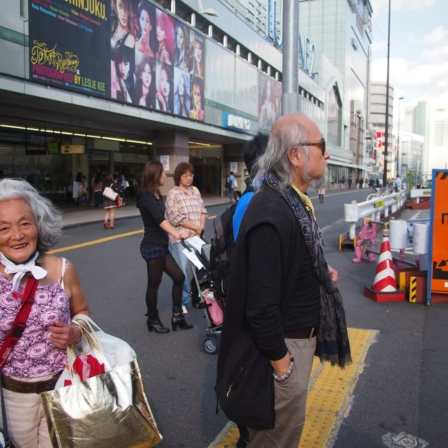The average human lifespan continues to increase. Every five years, we get 12 more months to live. The number of additional years has been increasing for the last century – counting from the time when the average lifespan of Europeans was just 40 years. The increase in human lifespan seems to be continuing, with no end in sight.
Baby girls born in Japan and the Nordic countries today will live, on average, to be 100 years old, or even more. In 2060, every third citizen living in Europe will be over 65 years of age. In Japan, this level will be achieved as early as 2030.
Hiroko Akiyama, a professor at the University of Tokyo’s Institute of Gerontology, has analysed the rapid demographic changes in Japan. Whereas in 2005, some nine per cent of the population was over 75, in 2030 this will already be true of every fifth citizen. In 2055, people over 75 will comprise almost one third of the population. In 2005, the share of people under 14 years old was 14 per cent; in 2030, under 14s will account for only one tenth of the population. With the way things are going, in 2040 there will be a new centenarian ready to welcome each Japanese baby brought into the world – as many centenarians as there are newborns.
According to the UN, this declining trend, which began in 2006, will reduce the population of Japan from its current 127 million to 114 million by the year 2030. The number of working Japanese will drop over the same period; while the current number of people actively working is 81 million, in 2030 this will have fallen to 67 million, representing a drop of 17 per cent. The ageing Japanese society will have to change – in terms of structure and culture alike.
Fitter, for longer
A better definition and concept than simply “ageing society” might be “a society of longer lives”. I have had many a discussion in Japan with experts in ageing. They feel that over the last few years public discussion and definitions related to the ageing society have not reflected the true reality: age that is chronological and numerically bound can no longer be regarded as the proper measure of ageing and adult life, nor can ageing continue to be viewed as a disease. Old age does not begin at 65. The older we get, the less our chronological age matters. One 70-year-old Japanese person may perform like a 50-year-old, while another may feel old inside and look almost 90.
Demographics researcher Takao Suzuki has been measuring people’s walking speed in the Tokyo metro for some years. The results show that the physical fitness level of elderly Japanese people has significantly improved over this time. According to Suzuki, the physical fitness level of citizens has “grown younger” by 11 years over the past two decades.
Thanks to effective and advanced health care services, geriatric diseases and the need for support have decreased over the past decade for both males and females.
Elderly people retain their cognitive ability, competence and performance levels much longer and better than the generation before. In Japan, an 80-year-old person is nowadays at the same level, in terms of health, as a 70-year-old person of twenty years ago. Looking at the ageing Japanese society, it should be readily apparent that, instead of monitoring chronological age, much more attention should be paid to people’s biological, health- and competence-related “age”.
A boon not a burden?
Research conducted by Professor Ursula M Staudinger, Vice President of the German National Academy of Sciences, Leopoldina, has drawn interest in Japan. In this research, she has shown that the cognitive and functional competence, ability to learn new things, plasticity and adaptability of elderly people develop throughout their lives.
At 65, Japanese women have a sumptuous 25 years left to live, while Japanese men have 20 (on average). Almost nine out of ten Japanese women retain their independence and ability to manage their everyday lives beyond 80 years of age. Enhanced old-age support and health care are only required during the last two to three years of their lives. At 65, men can expect an average of 18 years of active, independent living before the very last stages of old age entail societal and health-care-related support.
Since the Japanese have several years of life ahead of them, the focus should be on enabling an active and – from the ageing point of view – high quality of life, and not on the discussion about the costs of caring for the elderly and the care policies of an ageing society. How are we to implement a new type of socially fair and healthy society, in which people’s additional years of life are seen as having potential and, in terms of the individual, the gift of a longer and better life?
Another challenge is how modern-day Japan might utilise the increasing biological health, functional capacity and ability to perform of ageing people, as well as their strong cognitive and competence potential, to keep them as part of a productive society.
85 per cent of Japanese people over 65 want to work, and to continue in their jobs beyond the official age of retirement. In Japan, the population size will dwindle as the age structure changes. Once the deterioration of human functional ability previously associated with ageing and chronological age ceases to be a law of nature and people’s lifespans increase, Japan – and, within the next ten years, also South Korea, China, Hong Kong, Singapore, Taiwan and indeed most developed countries – will face the question: what kind of opportunities are provided by the population’s additional years of life and increased lifespan? What types of challenges do these issues pose to societies?
In Japan, young people’s share of the labour force is constantly dwindling. Many specialist sectors are lacking qualified personnel. In the future, there will be fewer and fewer qualified professionals in the labour market. In Japan, older employees returning to their jobs after official retirement is a common occurrence. Japanese people want to work long after reaching 70. This means that even though the population may be decreasing in size, demographic changes mean that the size of the labour force may not necessarily drop.
Learning for longer
According to the Swiss researcher Uschi Beckes-Gellner, in most sectors older employees retain their level of productivity and competitiveness much longer than is currently assumed. Ageing employees are not exhibiting problems to the same degree as they might have done before – especially in the case of work that places emphasis on experience and expertise. Practical impediments related to ageing (e.g. reduced eyesight and strength) can be removed with various kinds of work-related and technical arrangements (e.g. light, larger displays).
In order for an ageing population to maintain its motivation to work and remain longer as an active part of a productive society, it is paramount for individuals throughout their lifespan to see constant opportunity for learning new things, educating themselves, and advancing their careers even after 60.
Empirical studies also show that a society of long lifespans can remain competitive. In Japan, it is understood that work and community comprising different age groups, the “age mix”, will be a crucial competitiveness factor in the future. An “age mix” works well in specialised sectors and types of production, where there is knowledge of how to take advantage of this life experience. With increasing competitiveness, leaders and organisational HR functions must show creativity in combining the speed, conceptual ability, enthusiasm and hunger of young employees with the expertise and lifetime understanding possessed by more experienced employees.
With older people remaining part of working life for longer, productivity measurement systems must also be developed and expanded. Instead of the conventional indicators used to measure individual productivity, we should rather measure the overall productivity of organisations and companies. After all, even the results of slightly more complex work are nowadays calculated through the combination of work performances and simultaneous functions that may vary greatly.
The increased population lifespan coupled with a reduced birth rate is permanently changing the demographics and age pyramid of Japan and, soon to follow, other developed countries. We must acknowledge the facts pertaining to most developed countries and accept societies with many more old people and far fewer children and adolescents.
Changing our way of thinking
According to some estimates, in 2050 only 14 per cent of the population of a European country such as Germany will be under 20, while 40 per cent will be over 60. Therefore, in societal terms, ageing is more and more what we define it to be. The development in Japan indicates that we in Finland face a large-scale social and cultural task of changing the prevalent notions regarding ageing and old age.
In my opinion, this work should start right away.
At least two billion new people will be born on this planet over the next four decades. Nine out of ten of these people will be born in developing and underdeveloped countries.
It may be that in the future, national competitiveness will take the form of a competition pitting the adaptability and cognitive skills of developed nations against the sheer number of people and size of a young labour force in developing nations. Many ageing societies such as Japan – when compared to societies full of young people but fostering conservative values – may be significantly “younger” in terms of skills in information management, competence and adapting to change, which will enable them to compete successfully in the development of innovations.
Guy Breton, rector of the University of Montreal, told me in Kyoto that Canada will be channelling 13 per cent of state research resources to the study of old age. The objective is to make Canada an active society of ageing and young people, with the ageing sector occupying a broadly-based central role.



Recommended